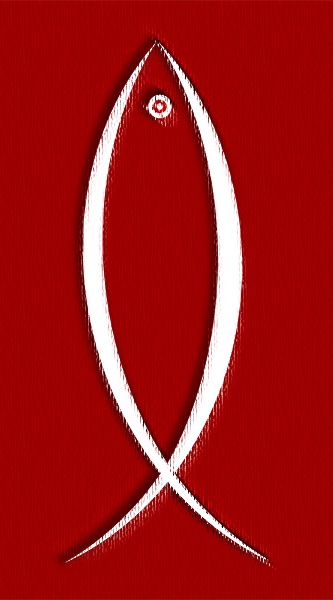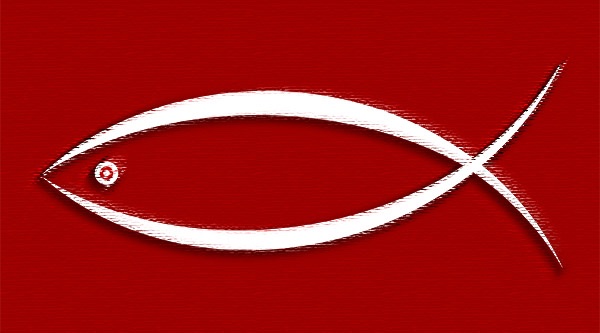
Hey, warning, there is more unnerving news for the righteous:
Guess what I learned yesterday?
The somewhat controversial vulva was the inspiration for the ichthys – the so-called Jesus Fish – one of the universal and most beloved symbols of the Christian faith.
I’ve been writing about the vulva ever since Maria created some vulva potholders as a symbol of freedom and strength for women. Some people didn’t like it at all. You would have thought I was running naked through Times Square.
Turn the vulva sideways and you can see it for yourself. i wonder if the good “Christians” who left my blog the other day in protest against Maria’s vulva potholders have any idea how Christianity was conceived, or what it’s symbols mean.
Perhaps not.
By now, I am used to encountering people who arrogantly invoke what it means to be a Christian while knowing absolutely nothing about Jesus or the founding ideology of Christianity.
Janice, a researcher and reader of the blog got my attention when she sent me this message yesterday:
“Jon, I believe you will find this bit of historical perspective interesting that I came across when researching the early church. The symbol of the fish displayed extensively by many Christians today was actually the symbol of the woman’s vulva. Turn it horizontally and you can see it. I do it mentally every time I see it on a bumper sticker. And chuckle to myself. If they only knew what they are promoting.”
Janice, thank you so much for alerting me to this, I put my reporter’s hat on and spent the next couple of hours poring over a number of Christian and academic websites focused on the early Christian faith, and I found a half-dozen studies and reports confirming what Janice said.
The much defamed vulva helped give birth to the Christian faith, it turns out the humble volva is actually the same symbol the pagans used for the vulva.
Go see for yourself.
Images of the vulva, one of the earliest known examples of cave carving, are also one of the oldest known examples of any kind of art work.
The vulva-shaped ichthys or “Jesus fish,” perhaps the most prominent symbol of Christianity apart from the cross, was originally a pagan symbol representing almost every pre-Christian fertility goddess from Atargatis, Aphrodite to Artemis.
When the founders of the faith gathered to spread the word about Christianity, they embraced many pagan symbols in order to attract pagan new comers to the church. Since the prophets and Popes of the new Church were men, they also needed to knock down the Goddesses the pagans worshipped.
Until the rise of Christianity, Pagans had always worshipped goddesses and celebrated fertility as the source of all life (rather than a source of shame and “disgust.”)
The people who drafted the Gospels and early Biblical writings were all mostly older men.
They altered the status and power of women in their new faith. Over time, men have insisted that women be ashamed of their bodies and hide them, since women are presumed to be evil and dangerous to men.
The goddesses were absorbed into the church and turned into saints, all of them now deferential to the hierarchy and authority of the church.
The early Christians also took existing pagan symbols and gave them new meaning.
Asherah, the ancient goddess of new life, and her symbol the snake, who sheds his skin to demonstrate regeneration, became an associate of the devil, who in Christian dogma, now carried her snake with him everywhere to show that women are innately evil.
No wonder women started to hide their vulvas.
In fact, the vagina (and the vulva) were once considered a profoundly sacred thing, the gateway between heaven and planet Earth. (I like that description, it’s how I feel about vaginas) I recommend The Vagina: A Literary And Cultural History by Emma Rees.
In the Indian Tantric culture 1,500 years ago, people believed that female body parts were life-giving, and if men ever wanted to achieve balance and health, they must learn how to respect and handle that region of a woman’s body, which was referred to as a “flowery pool” or “mysterious gate.”
Last week, a number of women who read my piece about Maria’s vulva potholders told me they thought it was “disgusting” and “gross” and sacrilegious for me to even show them on my blog. Several people who called them “Christians” left the blog in horror.
As it happens, icthys is the Greek word for fish, which inspired the name of the child of the fish-goddess Atargatis. The worship of Atargatis pre-dates Christianity by hundreds of years, and used fertility (the vulva) and then the resulting fish. Historians and theologians and researchers all say that was the origin of the fish use as a universal symbol of Christianity.
Maria thought the vulva is special, but I’m not sure even she knew how significant it is as a symbol of spirituality and religion. I wonder what the proper Christians who fled in disgust from the vulva might make of it now.
In our country, there is real concern about whether truth or facts matter any more. I think they do.
So thanks Janice, I am loving the tour of vaginal history you provoked. Actually anyone can take this trip, I recommend it. I hope the women who seemed to find this part of them disgusting will read more about it and learn about the history of their bodies.
There is nothing there that I find disgusting, gross or hateful. I do celebrate the vagina, and not just for women. For me as well.


Would love to see this idea captured in a bumper sticker!
It’s not something for me, you might ask maria…maria@fullmoonfiberart.com
Maria is now selling vulva decals…check out her website..
If you can’t beat them, rewrite.
tho’ I prefer:
Resistance if futile; you will be assimilated.
This is such interesting history to learn. Maria’s instinct was right on! I told her that I was laughing when I read her blog about it because it makes me want to flip all those fish on cars on their ends where they belong! ?
I love this post Hazel…
At 18 I laughed when I read that church towers were symbolic of the male energies. At 60 something, I’m happy to see that the gals are finally included.
Jon, this is your best post yet!
I cringe every time I hear the Vulva called the Vagina. I was called crazy once when I told someone they were wrong, that the Vagina is the birth canal and the Vulva is the outer part of our anatomy.
You need to stop cringing, I think…
So much for commenting yesterday. You didn’t bother to use it. Why? “There is nothing there that I find disgusting, gross or hateful. I do celebrate the vagina, and not just for women. For me as well.”
The article was about the VULVA, not the Vagina. Are you also confused as to which is which?
Yes, I am sometimes confused about which is which, Lorlee, for sure, not having either a vulva or a vagina.
I think I am quite clear these days, even though I might slip up every now and then.
I am not aware of ignoring any of your many condemnations of my behavior, but I don’t sit on the computer all day awaiting your messages. I get a lot of messages.Sometimes it takes a couple of days.
I asked you once before to move on, this dialogue is no longer productive, positive or useful in my mind, the kind of endless back and forth I work hard to avoid on my pages. Your posts are just getting nasty, and I have moved along to other things. I think in one of your messages you lectured me on the difference between denigrating someone and arguing with them. Good thoughts. I think it’s time you stopped doing it. Glad you don’t find your vulva disgusting or gross, I have never said that you did, or thought that you did, and frankly, I’m not interested. I am finding your messages edging towards hateful, though, and I have trouble with hypocrisy. So to be clear, and as a courtesy, I am informing you that I will not post or respond to any more of your messages on this subject. I’m sure you have a rich and full life, time to get on with it.
Great piece. And I thought I was one of the few to find this out. As for the men learning about this part of Christianity, what happened to Paul ands myself must happen to them before the “fish” And her nourishment to the rest of the planet is nonexistent. The Holy Spirit must come and cause them to turn. The practice of the faith that Jesus practice is a wonderful and marvelous thing.